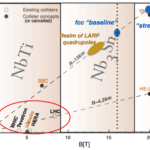Proton and ion colliders for high-energy physics, with their requirement for high magnetic fields, have driven the development of the most advanced superconducting magnets since the early 1980s and continue to do so. BCMT traces one of its deepest roots to the early days of this field and is now among its leaders, with an unparalleled integration of design tools and a series of field-strength records in accelerator-style magnets.
Base Program: A Common Foundation for Advancement in Many Areas
|
DOE Conductor Development Program: Expanding the Most Fundamental Frontier of Magnets
|
|
LARP: Next Chapter in the LHC Story
|
||
 Besides R&D that is strongly focused on magnets for a particular project, we have a base program that performs research of long-term or general benefit. This is the home of high-risk but high-potential-payoff R&D that expands the limits of technology, a high-leverage investment with a wide variety of applications.
Besides R&D that is strongly focused on magnets for a particular project, we have a base program that performs research of long-term or general benefit. This is the home of high-risk but high-potential-payoff R&D that expands the limits of technology, a high-leverage investment with a wide variety of applications. The goal of this ongoing is to provide cost-effective, high performance superconductors for next-generation high-energy physics (HEP) colliders. It is an industry-based national program which we manage on behalf of the DOE Office of High Energy Physics.
The goal of this ongoing is to provide cost-effective, high performance superconductors for next-generation high-energy physics (HEP) colliders. It is an industry-based national program which we manage on behalf of the DOE Office of High Energy Physics.  The latest of many upgrades to CERN’s Large Hadron Collider is aimed at an order-of-magnitude increase in beam luminosity. Our primary role involves the final-focus quadrupoles that maximize the number of collisions. This will be the first major use of the brittle Nb3Sn superconductor in an operating accelerator.
The latest of many upgrades to CERN’s Large Hadron Collider is aimed at an order-of-magnitude increase in beam luminosity. Our primary role involves the final-focus quadrupoles that maximize the number of collisions. This will be the first major use of the brittle Nb3Sn superconductor in an operating accelerator.